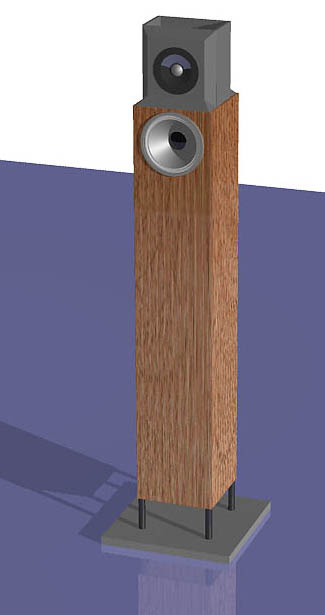| A Bipolar Transmission
Line Project -- the TLB
|
|
 |
Section 1: Introduction This speaker was not designed around a driver or a specific goal; rather it evolved from a series of experiments and investigations in psycho-acoustic concepts. It is a very modest sized column that is best appreciated as a chamber music or a jazz ensemble reproducer yet it will reproduce the texture of a full orchestra quite well. What it will not do is Rock SPLs or Movie sound effects. TLB is a small two way reproducer with big pretensions. I look upon the TLB as a musical instrument that has to be used with understanding that it has to have resonant space around it. You would not expect a flute to sound good in a closet and this speaker will not work placed in a corner or against a wall. It requires about 3 to 4 feet from the side walls and about 4 to 5 feet in back. This is not a very serious impediment since being small it can be easily moved. The second caution is while it is a TL, it should not be used as a beginners project to learn about TLs, since it uses techniques that modify the basic TL design parameters. On the other hand the concept is quite simple to execute, well within the skills of a beginner woodworker. It's big pretension is to provide a facsimile of the concert hall experience, ie a wide and deep sound stage and good imaging while optimizing the superior transient response of the TL. The means to the first is the implementation of a point source radiator up to the tweeter frequency and a bipole radiation pattern for the tweeter range. The second goal of optimizing the transient response, is phase linearity achieved with a minimal crossover and the exceptionally flat impedance plot. While the TLB will not reproduce the sub woofers range. it's low frequency reproduction is unusually tight, having minimal ringing on the falling pulse edge due to an unusual flat impedance peak that stores a minimal amount of energy. Several other techniques, discussed in the data section, are used to reduce the distortion products.The driver complement is: two Vifa 5" woofers, P13WH-00-08 and two Vifa soft dome tweeters, D27TG-45-06, per speaker. The drivers are chosen for the very smooth FR response and the ability to integrate with a minimal crossover, a single blocking capacitor to protect the tweeter. Thus the size and cost are modest, about $121.50 for drivers and about $30 for miscellaneous excluding the case finishing options. The documentation supporting the design is very technical and not necessary for the enjoyment of what is a very simple design. So you can skip it and going to the construction section 6, build the speaker. It is the music that counts. |
| < TL B click image for close up of top of speaker |
|
|
[ Contents | Introduction | Methodology | Radiation Response | Transient Response | Frequency Response | Construction ]
|
|